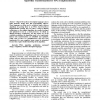Free Online Productivity Tools
i2Speak
i2Symbol
i2OCR
iTex2Img
iWeb2Print
iWeb2Shot
i2Type
iPdf2Split
iPdf2Merge
i2Bopomofo
i2Arabic
i2Style
i2Image
i2PDF
iLatex2Rtf
Sci2ools
DELTA
2010
IEEE
2010
IEEE
Algorithm Transformation for FPGA Implementation
High level hardware description languages aim to make hardware design more like programming software. These languages are often used to accelerate legacy software algorithms by porting them to an FPGA based hardware implementation. Porting does not always result in efficient architectures as the original algorithms are usually developed and optimised to run on a serial processor. To obtain an efficient hardware architecture, one that makes use of the available parallelism, the algorithms need to be transformed. Eleven such transformations are identified and explained. While some of these are straightforward, and have been implemented by some compilers, many cannot be automated because they require detailed knowledge of the algorithm. Keywords- FPGA, algorithm, architecture, automated design, compilation, hardware description languages
| Added | 10 Jul 2010 |
| Updated | 10 Jul 2010 |
| Type | Conference |
| Year | 2010 |
| Where | DELTA |
| Authors | Donald G. Bailey, Christopher T. Johnston |
Comments (0)

